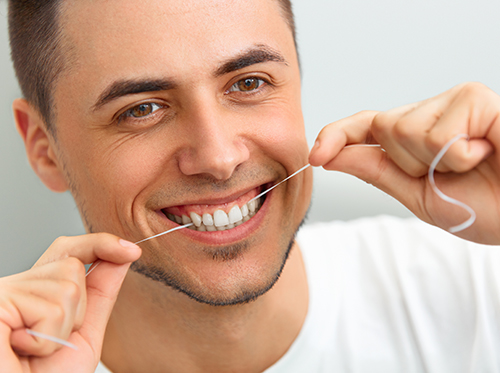October 10th, 2017

Spilling soda on someone’s white shirt, telling an off-color joke at an inappropriate time, or sneezing chewed food all over the dinner table all pale in comparison to the socially unacceptable, embarrassing blunder of having ... bad breath!
Five Possible Causes of Halitosis
- Poor oral hygiene practices. Failing to brush your teeth encourages anaerobic bacteria growth, which involves a type of bacteria that emits volatile sulfur compounds (gases) responsible for smelly breath.
- If you have tonsils, you may have tonsil stones embedded in the fissures of your tonsils. Tonsil stones are hard, tiny pieces of bacteria, dead oral tissue, and mucus that form inside tonsil crevices. When accidentally chewed, they release extremely foul odors that others can smell and you can actually taste.
- You have a chronically dry mouth due to medications, allergies, or persistent sinus conditions that force you to breathe through your mouth. Anaerobic bacteria thrive in dry, stagnant environments where oxygen content is minimal. Consequently, a dry mouth tends to lead to smelly breath.
- You have acid indigestion or GERD (gastroesophageal reflux disease). If you constantly belch stomach gases, this not only causes your breath to smell fetid but it can lead to enamel erosion and tooth decay.
- You have one or more oral diseases: gingivitis, periodontitis, or infections in the gums known as abscesses.
Improving oral hygiene practices may eliminate bad breath, but if brushing, flossing, and rinsing with a fluoride mouthwash twice a day doesn’t stop people from backing away from you when you open your mouth, it’s time to visit Richland Dental.
October 3rd, 2017

Flossing is one of the most important parts of your oral care routine. Many patients know they need to do it but find it difficult to fit into their busy lives. Well, here's the good news: flossing once a day is enough if you're doing a good job!
Some patients like to brush before they floss and others like to floss before they brush. Some like to floss in the morning when they have more energy, others like to floss at night so they can go to bed with a clean mouth. Don't get hung up on any of this, the important thing is that you floss and floss effectively no matter when you do it.
Effective flossing contributes to oral health in these ways:
- It reduces the chance of cavities between teeth, since cavities can only form on teeth covered with dental plaque and you're scraping that plaque away when you floss.
- Along with brushing, it reduces the amount of time the plaque is left on your teeth, allowing them to be in a state of healing and remineralization for longer.
- It removes plaque that accumulates at or below the gum line, aiding in the prevention of gum disease.
As you can see, flossing offers many benefits for such a simple and inexpensive technique. So if you're still wondering how much to floss, don't worry about it. Don't mistake the frequency of your flossing with the effectiveness of it. Choose a dental floss that you like and one time during the day when you can floss thoroughly and just do it! If you need more tips on how to floss correctly, ask Dr. Hilary Craddock and Dr. Joyce Pace or any member of our Richland, MS team—we'd be glad to help you pick up this healthy habit!
September 26th, 2017

Do you feel anxious before every dentist appointment? If the answer is yes, you are not alone—more than 75 percent of Americans feel anxious when visiting their dentist. Today, Dr. Hilary Craddock and Dr. Joyce Pace and our team thought we would provide some tips to reduce your stress about visiting our Richland, MS office.
The first thing we want you to do is plan ahead. If at all possible, book an appointment at a time when you know you won’t be in a rush to get somewhere else, such as picking up your children from school or an important meeting at the office. We also recommend you avoid caffeine and sugar prior to your visit as too much of either can make you feel even more anxious, not to mention jittery.
Once you’re here at our office, take some slow, deep breaths to relax. Then, try to relax your muscles by sitting back comfortably. If you are still feeling anxious, let Dr. Hilary Craddock and Dr. Joyce Pace or someone on our team know. We deal with nervous patients all the time and may have additional relaxation techniques for you to try. If you’d like, we also encourage you to bring headphones and listen to music of your choice to distract yourself while we work on your teeth.
If you have additional questions about relaxation techniques, or would like to schedule an appointment, please give us a call!
September 19th, 2017

Never before have dental implants looked as natural and aesthetically pleasing as they do today. With the help of computer-aided design and computer aided manufacturing (CAD/CAM), Dr. Hilary Craddock and Dr. Joyce Pace and our team are able to create implants with impeccable fit and finish. Although these technologies have been in use since the 1980s, it's only recently that they became efficient and cost-effective enough to be useful.
Dr. Hilary Craddock and Dr. Joyce Pace can also take digital scans of your teeth, providing a much more in-depth and accurate representation of them when compared to traditional X-rays. This scan can be used to create a physical model of your teeth through the use of 3D printing technology, allowing for the utmost in accuracy when planning your implant treatment.
Since each of our patients are unique, these CAD/CAM technologies offer a highly customized approach to implant dentistry that helps avoid the "one-size-fits-all" ways of the past. The goal is to have an implant look and function as closely as it can to the tooth it's replacing. That’s why these implants are typically milled using ceramic or composite resin — materials chosen due to their durability and resemblance to teeth.
Even the planning of your surgery can be aided and guided by computers. 3D CT scans create a digital representation of your mouth including all significant anatomical markers. This data is imported into planning software which, coupled with CAD/CAM implant technology, is able to 3D print surgical guides that snap into place over a patient's teeth. This means less risk for surgical error and much more accurately placed dental implants.
The main benefits of CAD/CAM dental implants are that they:
- Are extremely accurate for every patient, down to 50 micrometers
- Have better long-term results and more natural-looking implants
- Can be manufactured quickly, the same day in many cases
Of course this is just a quick summary of the benefits, and a computer-modeled implant may not always be the best option. If you have questions about the dental implants or the technologies we use to make them look as natural as possible, feel free to contact our Richland, MS office.








 Website Powered by Sesame 24-7™
Website Powered by Sesame 24-7™